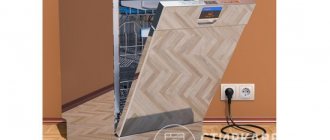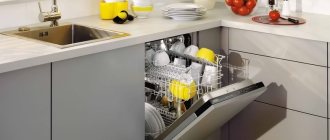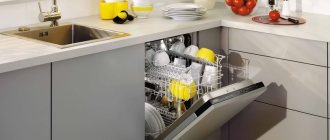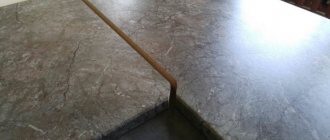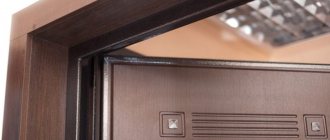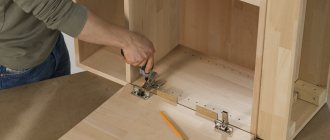If you bought a built-in dishwasher, then you now face several difficult tasks. You have probably already become acquainted with some of them earlier, when installing a washing machine. Indeed, in many ways these household devices are similar - the same connection to the drain, connection to the electrical network. However, a new task appears before you - fastening, installing the facade to the dishwasher. Many people think that this is an activity for furniture assemblers; however, installing a facade with your own hands is not difficult. In this article we will tell you what can be useful for carrying out such work.
How to install a dishwasher under the façade
Before starting work, read the installation instructions and make sure you can handle the job.
Remember to follow safety precautions. It is useful to watch a current video, for example. First, installation of communications is carried out: water supply, sewerage, electrical network. Only after a test check can the PMM be secured in a niche, under the tabletop, and a decorative panel hung. Fastening is done with bolts (screws, self-tapping screws) included in the kit. Along with fasteners, gaskets, instructions, you will find a stencil. Applying it to the cabinet walls, countertop (depending on the PMM model), draw the locations of the holes for fastening. They are easy to make with a hammer drill. Do not make through holes; drilling ¾ of the wall thickness will be enough. All that remains is to screw on the countertop protection and place the dishwasher in the cabinet. Last steps:
- Attach fittings, slider mechanism (if necessary).
- After attaching the stencil, determine the attachment points on the inner surface of the facade.
- Use a narrow drill to drill points, not all the way through, to avoid damaging the exterior finish.
- Remove the transport screws from the door (if equipped).
- If you are working without an assistant, try temporarily fixing the facade on the door with double-sided tape so that you can easily screw in the fastening bolts in the right places.
- Check the tightness of the fit, the quality of fixation, locking, and the presence of interference when opening and closing.
How to install it correctly with your own hands
The installation of the machine is carried out in several stages.
Park the car in front of the niche
First you need to unpack the dishwasher and install it opposite the niche. This is done to compare the size of the niche and equipment. If the structure is too large, you will have to increase the dimensions of the niche yourself.
Stretch the drain and inlet hoses, electrical cord
After preparing the niche for further installation of the dishwasher, you can begin to stretch the hoses for the flow and drainage of water. They are pulled through special holes to the connection points with sewer pipes.
Push the machine into place
Having pulled out all the communication elements, you need to place the machine in the place where it will be installed. After this, it is recommended to check that the hoses are long enough. If they are too short, you will have to install longer hoses.
Prepare the machine for installation
Before installation, the machine must be properly prepared. First, you need to install a film on the inner surface of the countertop to protect against the generated steam. Then fasteners are installed to which the equipment is secured.
Leg height adjustment
In modern models, all legs can be adjusted manually. This allows a person to independently monitor the height of the product and adjust it. The dishwasher should be installed in such a way that it is easy to use.
Soundproofing mount
Some types of devices are sold together with noise protection elements. They are installed on the walls of dishwashers and absorb some of the noise that comes from equipment during operation.
Installation of homemade overlays
Decorative overlays are needed so that the installed equipment fits better into the interior. Each such pad is attached to the surface of the equipment with ordinary screws.
At what stage should the façade be attached?
The dishwasher is installed in several stages. The main connection is considered to be connection to communications: water supply, sewerage system, dedicated power line.
Decorating the front side is usually done at the very end, when the rest of the work has already been completed.
The housing is pulled out of the niche to provide access to the car door from all sides. But during the fitting process, it is better to push the machine into place so that the panels of the dishwasher and neighboring modules are at the same level
Is it possible to run the dishwasher without the decorative trim installed? It is not recommended to launch before installation work is completed for several reasons.
Only a dishwasher that is completely closed on all sides can fully perform its functions; in addition, the panel plays the role of an additional sound and heat insulator.
Sometimes they mask the machine first and then make the connection. This option is appropriate if there is a delay in connection for objective reasons, for example, at the same time the riser in the toilet is being replaced or a new power line is being laid.
In order not to waste time, decorate slowly.
Connection to water supply
The water supply is connected to cold water. It is advisable to install a filter on the water, which will reduce its hardness. This will significantly extend the life of the device.
If you do not pay due attention to the quality of the water, the machine will quickly fail. The check valve in the device will break
This will cause even cleanly washed dishes to smell unpleasant.
How to properly connect a dishwasher
To prevent the check valve from malfunctioning, water filters are installed.
In addition, the water supply is connected only to cold water. It is not advisable to connect it to hot water, because the quality of such water does not meet the necessary requirements.
Stages of connecting the water supply:
- turning off the water - usually the tap is located in the kitchen;
- disconnecting the hose from the mixer;
- a tee is screwed onto the pipe and connected to the mixer;
- A ball valve is connected to the tee (in the middle branch). The latter has an outlet to which a hose from the dishwasher is already connected;
- a filter is installed on the outlet to retain debris.
Water supply connection
The dishwasher usually comes with a short hose. It may not be enough to connect to the pipe. In this case, it is recommended to purchase a longer hose. You should not try to build up the old one - this will be a very unreliable solution.
Connecting the dishwasher to the water supply
Instructions for connecting to the water supply
As a rule, flexible hoses from pipes with hot and cold water go to the mixer tap located in the sink. That is why the most convenient way to connect the PMM is located in the place where such a hose is connected to the water main. Otherwise, you will have to make a tap into the pipe using a tee or a manifold with two bends and taps. When connecting a flexible hose to a water supply, a tee with a shut-off valve must be installed under the sink.
A shut-off valve in the tee is necessary so that you can quickly stop the water supply in case of an emergency. Since most PMM models only require cold water, one tee will be required.
For work, you should prepare the following tools and materials:
- a tee with a built-in faucet, made of brass or bronze, with a thread diameter of 3/4 inch (this diameter is suitable in most cases);
- inlet coarse filter (if one is not included in the dishwasher kit);
- fluoroplastic sealing tape (FUM tape);
- adjustable wrenches;
- sharp knife.
If the kitchen already has a washing machine or plans to install one, the tee should be replaced with a manifold with two outlets with the same diameter (3/4 inch) and two shut-off valves (see photo above). In addition, some PMM models are equipped with inlet hoses that are too short, a little more than a meter long. If this length is not enough, you will have to buy a new hose from a specialized store.
To properly connect the dishwasher to the water supply with your own hands, the work should be done step by step, in several stages:
- Shut off the water supply to the apartment.
- Disconnect the flexible hose supplying cold water to the faucet from the water supply pipe.
- Connect the water pipe to the inlet of the tee or splitter by first winding FUM tape onto the thread.
- Connect the outlet of the tee or manifold to a flexible hose going to the mixer. Don't forget to use FUM tape.
- Connect the filter and dishwasher inlet hose to one of the side outlets.
- If you have a washing machine, connect its inlet hose to the second outlet of the splitter.
- Check the tightness of all connections by supplying water to the main line.
This completes the connection of the dishwasher to the water.
Sometimes the situation does not allow installing a PMM near the sink. In this case, you have to crash into the water pipe. If it is made of metal-plastic, there will be no difficulties. It is necessary to cut out a piece of pipe and install a tee or manifold with press fittings in its place to ensure a reliable connection.
There is no need to cut the metal pipe - just put a clamp with an outlet on top and drill a hole in the pipe through the outlet. This connection is also reliable.
When to hang a façade
The façade panel is fastened after all other communications have been connected to the machine. The device must be tested at idle to ensure that all mechanisms are working properly. And only then should you start hanging the façade plate.
Since it is necessary to accurately adjust the dimensions, the installation process includes alignment of the PMM in height, slope, and fastening to your own or adjacent cabinets.
In some cases, the design of the machine itself or kitchen furniture requires a specific installation approach: installing an additional false panel, adjusting the base strip, etc.
Each model has its own installation features. Sometimes manufacturers of furniture sets indicate which models of dishwashing units are best suited for their products. Large holdings, of which IKEA is the most famous, produce cars themselves in addition to furniture. In such cases, installation of the front panel is carried out without problems.
Connecting hoses and testing
We connect the hoses to the machine at the very end, but before the side fastening is made.
The housing moves forward to provide access to all components. Both hoses are usually attached to the body on one side, at the top or bottom.
They protrude a few centimeters, and to provide space in the closet, the back wall is usually simply removed.
The connection is made as described above: the hoses are inserted into the holes and secured with union nuts or clamps. No special tool is needed for fixing; everything is done manually, with a screwdriver or pliers
Once connected, the machine is placed in place for testing. We turn on the machine on the panel, then plug it into the socket, ensure the water supply and press the “Test” or “Start” button. How to perform testing correctly is explained in the instructions.
If there are no leaks, the machine does not hit the countertop or walls, and the test wash cycle went through without incident, then you succeeded in installing the dishwasher yourself.
But before you start using it, it is advisable to familiarize yourself with the rules of operation and maintenance of the machine.
Preparatory activities
Experts recommend that before attaching the facade panel, preparatory work is carried out, during which the necessary materials and tools are prepared.
Tool
To perform installation work, you will need special working tools, among which are the following:
- Screwdrivers. These are common tools that are found in almost every home. Most often they are used if it is necessary to screw in screws and screws. Screwdrivers may differ in purpose and size. The choice of suitable models depends on the type of fastenings used.
- Roulette. When carrying out installation work, it is necessary to take various measurements. For this, a tape measure is used, with which you can take measurements.
- Screwdriver. This is a hand-held electric tool that is often used for driving and unscrewing self-tapping screws, screws and screws. You can also use it to drill holes into which fasteners will be installed in the future.
- Marker or pencil. They will be needed to mark the places where the mounting holes will be drilled.
- Awl. This tool is used if you need to pierce holes in fragile surfaces. It is recommended to use a strong awl to prevent it from breaking during the piercing process.
Materials
To install the facade you will not need as many materials as tools. Among the most important materials are:
- Stencil. This is a very important detail that can help when installing the facade. With its help, the places where the mounting screws will be installed are marked. To use a stencil, you need to attach it to the panel and mark the places for fastenings.
- Scotch. For installation work, it is recommended to use double-sided tape. You will need it to attach the façade to the surface before screwing in the screws.
Preparation of tools and materials
No special tools are required to secure the façade trim.
The same items that are used to install the dishwasher as a whole will be useful:
- drill;
- screwdriver;
- awl;
- screwdriver;
- tape measure or ruler;
- pencil or marker.
If you don’t have a power tool, then one screwdriver is enough - you can screw in the screws by hand if the holes for them are pre-drilled.
The drill bit is selected according to the diameter of the screws: the holes should be a little tighter so that the fasteners are held firmly in the sockets
The work is simplified by the presence of a stencil for the façade overlay included in the delivery set. It is a large sheet of thin paper with marked attachment points.
The stencil is placed on the back side of the decorative panel and the places where the screws are screwed in are marked.
In addition to the tools, you will need double tape. Several “Velcro” pieces of tape will come in handy when you need to try on the facade. It is not recommended to immediately “mount” it on screws, since an error of 2-3 millimeters will mean all the work is in vain.
Don’t forget about the handle, without which opening the door will be problematic. It is also fixed with self-tapping screws, which are screwed into the back of the panel.
To ensure that the surfaces of the door and facade adjoin as tightly as possible, the heads of the screws should be recessed into the canvas.
It is easier to attach the workpiece than a homemade overlay. If you make the panel yourself, you may need carpentry tools, sandpaper for sanding, antiseptic impregnation and paint to finish the entire surface or just the ends.
Photos of dishwashers with furniture fronts
In any case, a facade masking a dishwasher will help create the desired interior without the difficulty of selecting equipment of a certain design. In addition, it will protect equipment from aggressive factors and extend its service life.
The difference between installing a built-in dishwasher and a freestanding model is that additional design is required for the front wall - the machine door.
It is assumed that the decorative panel is selected to match the surrounding interior, and then the facade is installed on the dishwasher.
Experienced craftsmen cope with a simple operation quickly, but beginners should carefully study the instructions and become familiar with some of the installation nuances.
The range of models integrated into kitchen units is much wider than their free-standing counterparts. This is explained by the principles of ergonomics and space saving inherent in the concept of constructing a kitchen interior.
To install a built-in dishwasher, you will need a separate cabinet, or rather, a niche in the set. It differs from a regular kitchen cabinet in that it does not have a back wall or bottom.
The equipment is built inside furniture modules and decorated with facade panels so that when closed it is completely hidden. This installation method allows you to maintain the kitchen interior in the same style.
The machine is installed directly on the floor, on 3 or 4 support legs. The absence of a rear wall allows for free placement of the water supply and drain hoses.
The cabinet must have reliable walls to which the dishwasher body is attached, and a “roof” - the countertop. The front panel is not fixed to the walls, like conventional cabinets, but directly to the car door.
No need to experiment with fasteners
: Manufacturers have provided installation features and prepared special holes for self-tapping screws.
What is a facade for PMM? This is a decorative panel, most often made of the same material as the front surface of the entire kitchen unit. It is made from MDF, plastic, laminated chipboard, solid wood or combined materials.
The fasteners are not visible from the outside, since installation is carried out from the inside, from the side of the machine door. Self-tapping screws are screwed into the holes and partially, not completely, enter the panel fabric
Where do you get decorative panels? There are several ways to make it:
- ordered together with a kitchen set if the dimensions of the machine are known in advance;
- make it yourself from the doors of a disassembled kitchen cabinet;
- if there is no suitable “extra” facade, they are selected in a similar style and color design.
The first method is considered the most practical: when ordering, all dimensions of the car are taken into account, so the facade “fits” perfectly.
Preliminary work before installation of PMM
There are two options for installing a dishwasher: yourself and with the help of specialists. In the first case, you risk connecting the car incorrectly; in the second, you will have to part with part of the family budget.
Sometimes the skills of one craftsman are not enough; you have to call a team of specialists: a furniture assembler, a plumber and an electrician.
Installation services for built-in equipment are offered by companies that sell them. For a certain fee, a universal master comes at the appointed time, carries out all the connection work and checks the serviceability of the machine.
However, if you carefully study the installation instructions, think about connecting hoses, find or install an additional outlet, you can save money and acquire new skills by doing everything yourself.
Choosing a location based on size
An important step is choosing a location for installation. For the built-in model, furniture modules of the first level are suitable, that is, cabinets standing on the floor.
But if you like a compact mini-dishwasher, then its installation is a little easier - such equipment can be inserted at waist or chest level (for ease of maintenance).
There are several conditions for choosing a good location. If they are not followed, you may later encounter problems with water supply/discharge or PMM maintenance.
Image gallery
Photo from
The furniture module adjacent to the washing unit is the most suitable place, since the water supply and drainage units are located nearby, so it is easy to connect the hoses. The length of the hoses should not be long, otherwise the supply and drainage of fluid becomes difficult, which often leads to breakdowns
Prudent owners, even at the stage of interior planning or renovation, think about installing several grounded outlets for powerful household units. If there is no free power point, you will have to draw an additional line
The machine must be placed freely inside the furniture module, with a margin of 5 cm on each side - more precise information is provided in the instructions. The cabinet walls must be strong and able to withstand the fastening elements and the weight of the dishwasher. Rear wall not provided
You should not expect that the machine will be installed once and for all. Sooner or later you will need to replace parts, reconnect hoses or clean some elements. Therefore, the installation is carried out in such a way that possible dismantling is easy and access to communications is open.
Built-in dishwasher next to the sink
Separate grounded socket for dishwasher
Suitable cabinet for dishwasher dimensions
Dishwasher Maintenance
Many installation difficulties arise when a dishwasher is integrated into an already installed kitchen set. You have to adjust cabinets to fit, and sometimes dismantle and remodel some of the furniture.
We recommend that you take care of the installation location before purchasing furniture. This also applies to other household appliances that require integration. Usually, the models you like are first selected, and when drawing up a sketch of the headset, their location and exact dimensions are taken into account. We have provided recommendations for choosing a built-in dishwasher in this material.
Preparation of tools and materials
Manufacturers of built-in PMMs sometimes list in the instructions what tools may be useful during the installation process. However, they expect that preliminary work has already been done.
If measures are required to lay a power line or tap into a pipe, the list of necessary items will increase.
To be on the safe side and save time, you should stock up on the following tools:
- hammer drill or powerful drill;
- adjustable wrench;
- hammer;
- a set of screwdrivers, including flat and Phillips;
- chisel;
- pliers;
- laser level;
- tape measure, square, pencil;
- screwdriver
In addition to tools, you will need connection parts. It is not recommended to use used elements - this will reduce their service life.
To install a socket, you need to buy the electrical installation product itself, a socket box for it, a three-core copper cable, and an additional automatic protective device.
There are special requirements for the socket: it must be of a “European” type, with grounding, preferably protected from moisture, fully operational, without damage
To connect water, you will need a metal tee for inserting into the water supply system, fum tape, a tap for shutting off water, rubber gaskets, clamps or ties for fastenings.
If the siphon is not provided for connecting another drain hose, then it will also have to be changed.
If the voltage in the network often fails, we recommend purchasing a stabilizer. It can be installed on several devices at once.
Types of dishwashers
Modern dishwashers are divided into three main types:
- Tabletop;
- Freestanding;
- Built-in.
The smallest machine is a desktop model. Its dimensions allow the unit to be installed directly on the countertop. Free-standing models only require connection to the power supply and communications; they are installed as a separate module or in the niches of a kitchen unit. It is the built-in models that cause the most difficulties when installing communications and installing the machine itself, which will be discussed below.
The advantage of a built-in dishwasher over other models is that they do not destroy the integrity of the designer’s idea or simply do not violate the aesthetics of the interior of the room. Built-in dishwashers are hidden under a box that is part of the kitchen unit, and their facades are covered with decorative facades. If your kitchen is small, then the built-in model is just for you.
Even when placing an order for a new kitchen, the installation of a built-in dishwasher can be ordered from specialists. But this is not always convenient due to extra costs. In addition, in order to correctly accept the work in order to avoid further troubles, you should delve into the nuances of the installation carefully.
We determine the location and calculate the dimensions
The installation of a built-in dishwasher must be planned immediately, along with the entire kitchen interior - this will be an ideal option. Take my word for it, it is much more difficult to find a place and install a built-in machine in a finished kitchen, so the sooner you think about the need to install a dishwasher, the better. Plan ahead and draw a sketch of your future kitchen. Try to take into account the location and size of all household appliances.
In addition, draw on the sketch the location of all electrical and plumbing communications. In this case, each socket, each pipe outlet will be in its place and will not interfere with the installation of household appliances in the future. You can see an example of a kitchen sketch in the picture below.
Some people believe that before ordering furniture for the kitchen, you need to buy household appliances, and only then, based on their sizes, make a drawing of the future set. This is not to say that this is a wrong approach, but rather inconvenient and expensive.
- Firstly, to buy all the equipment at once, you need a lot of money at once, and then almost immediately pay for the kitchen furniture.
- Secondly, the purchased equipment will need to be stored somewhere while the kitchen interior is being formed, and this may take several months.
- Thirdly, even if you buy equipment in advance, this also does not guarantee that the furniture makers who will make the set will not miscalculate the dimensions somewhere.
In general, experts say this: first look at the model of a built-in dishwasher at a retail outlet, measure its exact dimensions, and do the same with the rest of the built-in and non-built-in appliances. Next, give all the dimensions along with the sketch to the furniture makers; if they miscalculate somewhere, then you can try to correct this shortcoming by purchasing smaller equipment. For a built-in dishwasher, do the calculations like this.
- For example, a built-in dishwasher has dimensions WxHxD 450x820x550 mm.
- You will need to allocate space for the cabinet into which installation will be carried out, taking into account the thickness of the material.
- You also need to leave a gap of at least 5 mm between the walls of the dishwasher and the walls of the cabinet.
As a result, for example, the total thickness of the material (on both sides) is 20 mm, plus a 5 mm gap (on both sides), which means we add 450 + 30 = 480 mm to the width - this is the final width of the cabinet with the dishwasher. We leave a gap in height only at the top, but take into account the height of the legs. That is, the height of the legs is 60 mm, we add the total thickness of the material 20 mm and a gap of 5 mm, we get 820+60+20+5=905 mm - the minimum height of a cabinet with a dishwasher.
When calculating the depth of the dishwasher, it is necessary to leave space for hoses and electrical wires, about 80-100 mm; the cabinet may not have a back wall, so there is no need to include the thickness of the material in the calculation. We get 550 mm+100 mm=650 mm. As a result, the dimensions of the cabinet with a built-in dishwasher will be at least WxHxD 480x905x650 mm. Successful connection and installation of the “dishwasher” entirely depends on how correctly you calculate everything.
Preparing tools and components
Before connecting the dishwasher with your own hands, you need to prepare tools and components. The composition of these tools and components will depend on the features of the kitchen unit, the removal of communications and other factors. It is best to select everything you need immediately before installing the “dishwasher”, when there is a clear plan, a ready-made sketch and a partially formed interior. Approximately the following tools may be required:
- small adjustable wrench;
- flat and Phillips screwdrivers;
- tape measure (preferably laser);
- pliers;
- perforator;
- screwdriver;
- chisel.
As you can see, the list is small. Indeed, to install a “dishwasher” you don’t need any special tools, but you may need quite a lot of components.
- European sockets.
- Socket boxes.
- Copper two-millimeter cable with three cores.
- Tee for metal-plastic water pipe.
- Tangit type fumka.
- Tap on the inlet hose.
- Difavtomat.
- Set of rubber gaskets.
- Siphon with at least two outlets for drain hoses.
- Set of plastic clamps.
Sockets, a circuit breaker and a wire will be required if you are preparing electrical communications for kitchen appliances. Take sockets of the highest quality possible, with protection from moisture. For information on how to choose the right socket, read the article How to choose and install an socket for a washing machine. Although this text is about sockets for washing machines, the features of choosing a socket for dishwashers are absolutely identical.
Types of Dishwashers
Dishwashers in the kitchen, designed to make the housewife’s work as easy as possible, should not create discomfort, disrupt the design or take up a lot of space in a small kitchen. Before you build a dishwasher into your kitchen, you need to choose one of the design modifications that are made. For ease of use, dishwashers are available in three main size groups.
There are several variations of household appliances for automatic dishwashing
- Full size.
Their height ranges from 82 - 87 cm, width 60 cm, depth 55 or 60 cm. They serve the most dishes (up to 17 sets) and can stand alone in the kitchen or be built into the kitchen furniture partially or completely. In partially built-in designs, the panel control of the machine remains outside, completely built-in - located on the upper edge of the open doors of the machine. - Narrow.
They differ from the previous class only in width (from 45 to 49 cm), they wash no more than 9 sets of dishes, depending on the model. The type of arrangement in the kitchen area is similar to full-size types. - Small compact modifications
have all the dimensions of full-size machines, with the exception of the height - it is 1.5 - 2 times lower, as for the number of dishes washed at the same time, their ceiling is 5 sets. In the kitchen, they are installed directly on the top of the countertop or mounted in a niche of the kitchen cabinet as a separate module. One significant drawback of this type of machine can be noted - unlike other models, due to their design features, they do not provide water supply to the lower basket with dirty dishes, which worsens washing quality.
Mounting methods
It is no secret that fixing the panel is very important; special attention must be paid to it.
There are two ways to attach the facade.
Partial fastening . In this case, the panel covers the main part of the door, while the control panel remains visible.
Full installation. The dishwasher door is completely covered by a panel.
The most common fastening is using self-tapping screws. They are screwed in from the inside. It is necessary to choose the correct length of screws. This way you can avoid seeing the screw heads on the outside of the panel. Another common fastening is hinges. They can be purchased complete with the facade. They are attached near the bottom edge of the dishwasher.
It is strictly forbidden to attach the facade to any kind of glue. During operation, the dishwasher door can either heat up or cool down, depending on the dishwashing mode. Due to such differences, the glue may lose its properties and, as a result, the panel will fall off. It is also possible that the glue will firmly stick the panel to the device door, which is also inconvenient. If dismantling is necessary, it will be impossible to peel off the panel. Another mistake is to glue the panel with tape. This fastening is not enough to hold the panel. While the machine is operating, the facade may simply fall off.
What is required to install the facade?
If installing a dishwasher is a rather complicated procedure, then you can install a façade on it yourself.
For these purposes you will need the following equipment:
- furniture panel (in this case, its appearance will directly depend on the design of the kitchen unit);
- suitable tabletop;
- yardstick;
- screwdriver;
- necessary accessories.
How is the facade installed?
There can be several ways to install dishwashers: installing the equipment in a ready-made kitchen unit or separately from it. You will only need to hang the door in the first case, and performing such a manipulation is very simple, since well-known manufacturers have described in detail all the necessary steps in the instructions.
To hang a facade on a Bosch machine, follow the following algorithm:
- To begin with, the equipment is mounted in the designated place at the required height using special screws. It should be noted that built-in models are already equipped with ready-made templates, using which you can easily install the furniture facade to the door of the dishwasher.
- Fastening elements are attached to special grooves located on the machine body. Next, you will need to replace the small “original” screws located on the inside of the door with longer fittings with nuts. Thanks to this, the furniture facade will hold more firmly. Finally, all that remains is to attach the handle and decorative elements to the door.
- Installation of the facade can be done in another simple way. Before directly fixing it to the bolt, you need to apply double-sided adhesive tape. Experts also recommend that when connecting equipment to the electrical network, use a cable that has a cross-section of 1.5 mm. As for the outlet, it must be grounded. The required parameter is 16 Amperes.
You can see how to install the front on a dishwasher in the video. All recommendations given should be followed exactly. If they are followed correctly, the decorative door will be installed without any effort and with minimal time. If you don’t have confidence in your own abilities, then you can always entrust this procedure to experienced craftsmen who know all the intricacies and features of its implementation.
Hello, dear reader! I’ll tell you about the nuances of installing a dishwasher under the countertop. There is a lot of information on the Internet about connecting the machine to communications, but the topic of integration into the kitchen set is not covered. Although the topic deserves a separate article.
Thank God, there is enough experience in installing a dishwasher in the kitchen to eliminate unnecessary movements and thoughts on your part. You will know exactly what to do. The result is a perfectly executed installation.
- Dimensions of the niche in the cabinet for the dishwasher
- Dishwasher Mount
- Correct placement of the dishwasher in the kitchen
- What to do with the plinth under the dishwasher
- Video on the topic
- Conclusion
How is installation done?
The façade canopy is made only if the dishwasher needs to be installed in a ready-made kitchen. Due to the fact that many of these devices come with installation instructions, this should not be a problem.
To install the facade, a handle is first attached to it, which will open the Bosch, Electrolux, Kandy, Ariston or Indesit dishwasher. After this, it is necessary to install fasteners adapted to engage with the door of the device. On the facade element to be installed there is a special paper overlay, which indicates exactly where the holes need to be drilled in order to apply the fasteners. You can drill directly according to the drawing to eliminate the possibility of error.
After all the holes are made, you need to install special fasteners. After this, the front is simply attached to the dishwasher. This happens by inserting fasteners into special grooves on the dishwasher door.
But the installation of the facade is not yet complete, since this hanging element needs to be secured. To do this, first open the car door and then unscrew several bolts from the inside of the door. They are replaced with longer ones, which will allow the facade to be attached. At the same stage, you can adjust the tension of the machine door springs by turning the screws. By looking, you can get a more accurate idea of the process.
Basics of installation and model selection
There are three main types of dishwashers:
- Freestanding.
- Partially built-in.
- Fully built-in.
If free-standing machines are placed anywhere in the kitchen, then other types of PMM “Electrolux”, “Ikea”, “Gorenye” and other brands are built into the furniture set. Initially, decide on the installation location and prepare a niche for the dishwasher. How to connect the PMM correctly, read one of the previous articles.
What materials are facades made of?
- Most often, modified plywood sheets are used, treated with a special compound that protects devices from sudden changes in temperature and humidity, and this always happens when equipment is operating. In addition, they do not harm human health and the environment.
- Natural wood panels are used very rarely; they require a special protective coating, so the cost is too high.
- As a budget option, you can use chipboard panels, but in this case you should carefully choose the top coating: it should saturate at least half of the sheet as best as possible, otherwise the material will quickly take on an unsightly appearance from moisture. And as temperatures rise, formaldehyde can be released into the air, which can negatively affect health.
Experts have an extremely negative attitude towards their PVC facades; they very quickly become unusable and the layers are destroyed.
It will also be helpful to learn more about how to install a small, narrow dishwasher under the sink.
Description
The facade is understood as a decorative detail of the kitchen interior, cleverly masking the unsightly appearance of the housing of household appliances. Typically, dishwashers are large in size, and most often they are built into existing furniture, so the facade serves not only an aesthetic, but also a practical purpose.
Many people use façade panels for several purposes:
- Disguising household appliances that do not match the overall design.
- For protective purposes: the panel will be able to prevent various types of damage to the case, for example, scratches, chips, dents, temperature changes, splashes, etc.
- The facade will help protect the device from the curiosity of small inhabitants of the house or animals who accidentally press the function buttons.
- Preventing excessive noise during equipment operation.
The video shows a description and installation of the facade in place:
Facade purposes
The facade of the dishwasher is a decorative panel element made from furniture materials. The main purpose of the facade is to hide the dishwasher in the kitchen furniture, making it part of the kitchen interior.
- there is no need to select the appropriate color of the machine; it fits perfectly into the interior, since it is a common part of the kitchen;
- the control panel buttons are almost invisible, children will not press them randomly;
- has soundproofing properties, the sound of the dishwasher is not so audible.
Dishwasher panels are made from a finely dispersed fraction; this is a medium-density wood fiber board. The thickness of the board is usually standard 16 mm (furniture thickness) and is covered with a film that completely replicates the texture, texture and color of the furniture.
In some dishwasher models, the open door can only be locked after the appliance plate is installed.
Determining the dimensions of the decorative panel
The final result of the work depends on how correctly the dimensions of the facade panel and its type are selected. To do this, you need to take into account the dimensions of the machine itself. The standard width of the device is 60 cm, the width of narrow models is 45 cm. The height of such household appliances is in the range of 80-85 cm, although there are examples with a height of no more than 50 cm. As a rule, such compact devices are chosen by owners of small kitchen spaces.
Experts emphasize the importance of choosing a front panel that matches the height of the machine. The upper part of the overlay should be level with the tabletop, a deviation of several centimeters is allowed so that the design looks organically with the facades of adjacent cabinets. In this case, you need to make sure that the doors open freely and that the remaining part does not interfere with this.
There are device models whose dimensions differ greatly from accepted standards. Therefore, it is better to equip a niche for appliances or buy a new kitchen set after purchasing a car. Only in this case can you make sure that the equipment will be perfectly installed and fixed in the box. If the height of the panel is slightly larger, it is not worth cutting it, since after removing the protective film, moisture will get inside the material and cause its rapid deterioration. It should be noted that the height of the dishwasher legs can be adjusted. This allows you to change the height of the equipment by a couple of millimeters.
Often, in order to determine the optimal dimensions of the decorating panel, you just need to read the instructions. This is where information is provided that may be useful in selecting a panel. The manufacturer specifies the required width, thickness, length and allowances of the product so that it fits the device accordingly. This is very convenient, since there is no need to make any calculations or measurements.
Purpose and features of the facade on the dishwasher
Before you begin installing the dishwasher front, you need to understand the purpose of this part. The front surface is a special decorative protective panel that is installed on the front of the dishwasher.
This product is made from various materials. However, most often when creating panels, the materials used in the manufacture of kitchen furniture are used. Externally, this part looks like an ordinary cabinet and therefore it is not easy to guess that there is a built-in dishwasher behind it.
Facade panels have a number of advantages that you should familiarize yourself with before using them. Among the advantages are the following:
- Improving the interior of the kitchen space. With the help of such a façade you can complement your kitchen design. Also, the use of such products simplifies the choice of dishwashers, since you do not have to select equipment that would fit the kitchen furniture.
- Dishwasher protection. The panel installed on the front of the machine reliably protects the equipment from mechanical damage and contamination. Most often, facades are installed to provide additional protection for household appliances.
- Soundproofing. It is known that during operation the dishwasher makes a lot of extraneous noise. After installing the facade panel, the equipment begins to work less noisily.
- Strength. Facade panels are highly durable and therefore difficult to damage. They are able to withstand even strong impacts on the surface.
Installation of the device
If connecting a machine seems difficult for someone, it is better to turn to professionals and not tempt fate. Although this process is quite simple, you just need to carefully study the instructions. And so, we do the following:
- Adjust the legs on which the dishwasher is installed so that the appliance lowers to the floor.
- We move the device into the prepared place.
- We make the connection - we connect a hose to deliver cold water, as well as to drain the used liquid into the sewer.
- The dishwasher can be plugged into a regular outlet, but experts advise making separate wiring from the distribution panel in the apartment.
- We raise the car to the desired height using the swivel legs and check the horizontal level with a building level.
That's the whole installation. Difficulties may arise only at the stage of connecting parts for supplying and draining water to the machine. But if you take the process seriously and responsibly, and most importantly don’t rush, then everything will work out the first time.
A properly selected and built-in dishwasher will not only please housewives, saving them from a labor-intensive process, but will also decorate the interior. And for those who do not want to show off their property, models that are completely hidden are suitable.
Door and front dimensions. Canopy and mount
The dimensions of the decorative panel depend on the size of the dishwasher. This can be narrow - 45-60 cm, full-size - from 60 cm or compact equipment - height 50-60 cm.
What to do if the dishwasher front is too long? You won't be able to cut it, as you will ruin the appearance of the set, because it is laminated on top and covered with decorative film.
What you will need for work:
- Screwdriver Set;
- roulette;
- fasteners;
- door handle.
Attached is a full-size template drawing, screws, self-adhesive tape, and fastenings. You can figure out how to secure the panel by following the instructions. For an experienced master this will take no more than 10-15 minutes.
Sequence of work when mounting
- Place the dishwasher in the prepared niche.
- Attach the cabinet to the cabinet panels.
- Make connections to the drain and water supply.
- Prepare holes for the handle using a Phillips screwdriver and an awl.
- After fixing the handle, you need to calculate the distance (Z), which will help place the facade flush with the rest of the kitchen doors.
- Take a tape measure and measure the distance between the door of the adjacent cabinet and the countertop, as shown in the figure (X).
- Then measure the distance from the mount to the tabletop (Y). Calculate: Z = X-Y.
- Place the template on the inside of the door.
- Use an awl to mark the locations for the fasteners.
- To make the fastenings more secure, drill holes ¾ of the way through the door.
- How to remove old screws? Sometimes the panels are tightened with short screws, but their length is not enough to fasten the facade. Therefore, you need to hang the panel, unscrew the old screws and install long self-tapping screws.
After installing the dishwasher under the façade, try closing the door. If the decorative part rests on the base, it means there was an error in the calculations. In this case, you can make a gap in the base as thick as the facade.
You can attach a decorative panel to Hansa and Miele appliances yourself.
Adjust the mechanism: tighten the bolt that secures the tension cable. Since the door is hinged, it should close easily with a gentle push of your fingers.
The video will help you make the correct hanging:
Connection features
So, step-by-step instructions on how to connect a dishwasher in stages:
- If you are installing a built-in PMM, then first you need to prepare a niche, which, as a rule, should be 60 cm wide, and for narrow models 45 cm. You can level the machine with the level of the cabinets by removing the tabletop and adjusting the legs of the lower cabinets. You also need to drill holes in the cabinet body for the drainage hose, water intake hose, and electrical wires.
- Installing a dishwasher under the hob is prohibited;
- The installation location is selected so that the length of the drainage hose does not exceed 1.5 meters. An increase in length up to 5 meters is allowed, but stable operation of the equipment in this case will be difficult to guarantee.
- The next step is connecting to electricity. Please note that the socket must be of the Euro type. You need to replace the socket if it does not meet the standards (but not the plug of the machine). Do not forget that we ensure safety when connecting, and the dishwasher has significant energy consumption. This determines the ban on the use of tees and extension cords. Installing a socket involves using a wire with a diameter of more than 2 mm. In addition, a 16A circuit breaker is additionally installed in the electrical panel. Grounding is also carried out using a 3-core wire, and it cannot be connected to pipes.
- Next is connecting the dishwasher to the water supply. To do this, the water is shut off, a tee is connected to the pipe, then a filter, a ball valve and a hen. All threaded joints are insulated with foam - it must be wound in at least 10 layers.
It is also necessary to install a coarse filter, as it will prevent sand and rust from the water pipe from getting inside the machine.
- As for connecting equipment to the sewer system, you can go the simple route by installing a siphon with an additional outlet and valve. In order to protect the device from water entering from the sewer pipe, you need to place the drain hose in a special way - at the point of exit into the sewer network, it is placed at a height of 600 mm along the wall, and then bent to ensure water flow.
- The final stage in connecting a dishwasher is checking the device for functionality. In this case, the machine is tested idle, controlling the rate of water flow, its heating, and operation in drying mode. The test is carried out without dishes, but with the obligatory addition of regenerating salt and detergents.
Types of materials and decor of furniture facades for a dishwasher
Various materials are used to produce dishwasher fronts.
Basically it is MDF. Since it is he who is able to withstand temperature changes and high humidity that occur during operation of the equipment. In addition, they are safe and do not contain substances harmful to human health.
Natural wood is rarely used in the production of furniture for a built-in dishwasher, since it is a very expensive material that requires a high-quality top covering.
If you want to save money, you can purchase a facade made of chipboard - it will cost the least. But keep in mind that if the integrity of the protective layer is damaged, the product will quickly lose its shape. In addition, when heated, it will release toxic fumes.
To give the structure the desired color and texture, a decorative coating is used. Modern solutions make it possible to disguise a dishwasher in such a way that it will be impossible to understand that behind the façade there is hidden equipment and not an ordinary cabinet.
The facade for a built-in dishwasher can be finished with the following materials:
- enamel coating;
- plastic;
- glass;
- metal;
- veneer (thin layer of wood).
Sizes - how to choose the right one
The size of the facade is calculated in accordance with the dimensions of the dishwasher. Typical models of household appliances are characterized by the following parameters:
Often the manufacturer indicates rounded values in the passport, so it would be useful to take measurements yourself.
The front part is always 1-2 cm larger than the front panel of the dishwashing unit, and it is also necessary to provide a reserve for installing fasteners.
To ensure that the height of the panel matches the countertop, adjust the position of the dishwasher legs. In the case of partially built-in equipment, the dimensions of the control panel are also included in the calculations.
If, after all the manipulations, the façade for the built-in dishwasher rests against the plinth when opening, then a small gap is made in it. It is equal to the thickness of the decorative panel plus 2-3 mm.
Possible errors and problems
There are several possible problems that people may encounter during the installation of façade panels. These include the following:
- Choosing the wrong façade. Some people initially choose the wrong panel, which is not suitable for the dishwasher. In this case, you will have to independently adjust the dimensions for the dishwasher or buy a new façade.
- Incorrect marking of mounting holes. There are times when people make mistakes in the process of marking places for future fastenings. This causes the dishwasher door with the panel attached to be difficult to open and close.
How to connect to the sewer yourself
For equipment to work properly, it must be properly connected to the sewer system.
Directly into the sewer pipe outlet collar
This is the simplest method of connecting a dishwasher to a sewer drain pipe. In this case, the outlet hose is directly connected to the cuff. The connection point is reliably sealed so that water does not leak.
Read also: Repair of LED lamps blinking
To the sink drain system
Sometimes it is not possible to connect directly to the sewer pipe and you have to connect the dishwasher to the washbasin drainage system. This is much more difficult, since you will have to buy a new siphon.
Connection to water supply
Dishwashers are connected to a cold water supply. Before connecting to the pipe, special filters are installed to purify the liquid. When connecting, a shut-off valve with a tee is installed, the joints are sealed with tape and sealant.
Power connection
Connecting your dishwasher to a power source is very simple. Just pull the cord to the outlet and plug it in.
What characteristics should you pay attention to when purchasing?
First you need to decide which model you want to purchase. There are two types:
- fully built-in dishwashers, the control panel of which is completely hidden;
- partially built-in.
Among the latter, there are devices that are not installed in a finished kitchen, but are intended to be placed next to other furniture. One of the most important characteristics is the width of the dishwasher. If a large number of people live in the house, then you should purchase a device whose capacity is equal to 12 sets of dishes. In cases where capacity is not of great importance, models designed for 9 sets are purchased. There are also machines for 6 sets of dishes.
Design features of built-in PMMs
From a design point of view, a wide range of models of built-in dishwashing units can be divided into two types:
- Partially built-in, in which when the front door is closed, access to the control panel remains.
- Fully built-in, completely merging with the furniture, and from the outside looking like an ordinary wardrobe.
The machine can be mounted from the side (to a separate cabinet or adjacent walls), from above (to the countertop). Some machines have the ability to mount in two ways at once.
It itself is installed directly on the floor, on legs that are height adjustable. The drainage and water supply connections are made from the rear side. Accordingly, a separate cabinet without a bottom and also without a back wall must be provided for installation.
When the PMM is placed flush with the rest of the set, there remains a gap between its back panel and the kitchen wall sufficient for technical wiring.
Tips for installing a façade
The following recommendations will help you avoid some mistakes and oversights.
- Be careful when choosing a façade. If the product is chosen incorrectly, you will have to adjust it to the required dimensions, which is extremely undesirable, or purchase a new one.
- Check that the fasteners are marked correctly. Otherwise, this will lead to the doors not closing well.
- Use measuring instruments. Only with a tape measure or ruler can you accurately determine the mounting locations. Do not use the "by eye" method.
- Choose screws of the optimal length. It should be such as to ensure reliable fastening of the panel and door, while the screws should not come out.
- Use a stencil. This device will help you make the markings correctly.
- Use an electric screwdriver. The tool will speed up the process significantly, which will save time and effort.
- Pay attention to the fastening of the handles. These parts are necessary in order to open the facade panel. It is very important that they are installed flush with the fittings on adjacent cabinets.
A dishwasher with an installed front will fit perfectly into any kitchen interior: from classic to high-tech. However, the work can be completed only after studying the necessary information and selecting materials and tools. If there is no appropriate practice or insufficient knowledge, it is better to entrust the work to specialists. Real craftsmen know the subtleties and features of the process, and will complete the work flawlessly and on time.
Problems with using a non-built-in dishwasher
First of all, you should pay attention to the problems associated with the operation of a free-standing built-in dishwasher. The thing is that there will be no difficulties with connecting and starting, since such a unit is designed exactly the same as a device that is produced separately. But experts do not recommend using a dishwasher regularly in this way. And that's why.
- Firstly, it's simply not aesthetically pleasing. It would seem like a small thing. But all the unsightly insides that should be hidden behind the facade (for example, soundproofing material) will be on the outside, which will immediately give your kitchen an unflattering appearance.
- It will be almost impossible to open the door of such a dishwasher without a front, especially if it is equipped with a tight spring. After all, a built-in dishwasher is designed to have a front and a door with a handle, and without them you will have to spend a lot of time getting used to it.
- Extra noise. Any dishwasher makes quite loud noises, but built-in dishwashers are much less equipped with sound insulation in the expectation that some of the sound will be absorbed by the set. Therefore, if you operate the machine separately, be prepared for noise during operation.
- The centrifugal force of a dishwasher is not as powerful as that of a washing machine, but it will still shake your unit quite well. This is not such a serious problem, but you need to be prepared for it.
It is best, of course, to be patient and wait for the kitchen furniture that will have a built-in dishwasher. Then there will be no worries or hassle, everything will work as usual. But if you really want to test the unit, take into account the above difficulties in order to properly use the device without embedding it.
What does the locking mechanism consist of?
First, let's look at the internal structure of the PMM to make it easier to determine the breakdown.
The locking mechanism is located inside the door and consists of the following elements:
- metal spring;
- cable (metal or fabric);
- plastic locking element;
- loops.
Some models, such as Bosch, also have closers that make the door move smoother.
The mechanism of operation of this system is simple. You open the dishwasher and thereby set the hinges in motion. This increases the tension of the cable, and it, after itself, stretches the spring. When the spring is stretched to its maximum, the locking element falls into a special hole and fixes the structure, preventing the spring from closing. At this moment, the PMM can safely be in the open position. As soon as you want to close it and move the door up, the lock will come out of the grooves and allow the spring to slam the door.
That is why PMMs that are not equipped with closers should be held when closing. If this is not done, the door will slam loudly and there will be a jerk that can damage the internal mechanisms or the housing.
